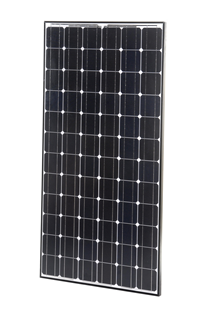Sanyo Panasonic 215 Watt Solar Panel HIP-215NKHA5
SKU HIP-215NKHA5- 215 Watt Peak Output
- Cell Efficiency: 19.3%
- Module Efficiency: 17.1%
- 5 Year Workmanship Warranty, 20 Year Power Output
- Hybrid mono crystalline silicon with amorphous silicon layers
- Perfect for high-power grid-tie and high-power battery charging using a MPPT charge controller.
Quantity discounts available!
For Commercial and Home Grid-Tie Solar SystemsHigh
Efficiency Power Guarantee Temperature
Performance Proprietary
Technology Structural
Strength Valuable
Features Quality Products *HIT stands
for Heterojunction with Intrisic Thin Layer. Supported by the New
Energy and Industrial Technology Development Organization (NEDO)
in Japan. Specifications, product design, and information on this
website are subject to change without notice.
About HIT Technology The SANYO HIT (Heterojunction with Intrinsic Thin layer) solar cell is composed of a single thin crystalline silicon wafer surrounded by ultra-thin amorphous silicon layers. This product provides industry-leading performance and value using state-of-the-art manufacturing techniques. Crystalline
silicon solar cell and HIT solar cell structure comparison HIT solar cells improve boundary characteristics and reduce power generation losses by forming impurity-free i-type amorphous silicon layers between the crystalline base and p- and n-type amorphous silicon layers.
News Release SANYO Introduces New HIT Power® N Series Solar Panels Dallas, Tx. - March 18, 2009 SANYO Electric Co., Ltd. (SANYO) The new series features the latest technological improvements including higher module output, lower voltage, space savings and lower installation costs that make the HIT Power® N Series the most efficient and competitive cost per kWh panels in the solar market today. The HIT Power® N Series solar panels will be available in North America from SANYO's authorized representatives, including SunWize Technologies, Conergy and Focused Energy from April. Today's announcement for the HIT Power® N Series coincides with the inauguration of SANYO's newest and most high-tech module production facility. SANYO, as announced in October 2008, is expanding its Monterrey, Mexico facility, providing up to 50MW in production capacity, more than double the current output amount. HIT® stands for Heterojunction with Intrinsic Thin-layer. HIT® solar cells developed by SANYO are hybrid solar cells composed of single crystalline silicon wafers surrounded by ultra-thin amorphous silicon layers. The unique structure minimizes defects within the p/n junction of the cell, producing highly efficient cells capable of achieving up to 17.1% module efficiency while producing more power even at higher temperatures. Using HIT Power® N Series solar panels allows maximum power generation per square foot, reducing the number of panels needed. The improved technology also features a higher output range (205 - 215W) and lower voltage (Vpm: 40.7-42.0V) – which means up to 60% more capacity per string and fewer parallel connections, cutting total installation costs. Each HIT Power® N module contains 72 cells that are 5" x 5" (125mm²), compared to HIT Power® B modules which contain 96 cells that are 4" x 4" (104mm²). HIT® cells offer superior temperature characteristics compared to conventional crystalline silicon cells. The result is 10% - (or more) - energy produced at higher temperatures compared to standard silicon-based solar panels. All HIT Power® N Series solar panels guarantee customers receive 100% of the nameplate rated power (or more) at the time of purchase. With more kWh per rated watt, SANYO's HIT Power® N Series solar panels quicken return on investment and are ideal for areas with performance-based incentives and renewable energy credits. The HIT Power® N series will complement the successful HIT Power® B series, which was launched in June of 2008. Like the HIT Power® B Series, HIT Power ® N series modules have enhanced materials for higher heat performance. Also, the HIT Power® B series and HIT Power® N series have similar frame structures and pre-drilled grounding and mounting holes for easy installation. The HIT Power® N series is unique, however, in its cell design and configuration. Summary of SANYO's HIT Power® N series new features: SANYO's HIT Power® N series solar panels operate silently and have no moving parts, making them among the lightest per watt in the industry. Unique eco-packaging minimizes cardboard packaging waste. In addition, the packing density of the HIT Power® N Series solar panels helps reduce transportation, fuel and storage costs per installed watt. The silicon wafers inside HIT Power® N Series solar panels are made in California, and then assembled in Mexico at SANYO's certified factory – ISO 9001, 14001 and 18001. For more information on SANYO's HIT Power® solar panels, please visit: http://us.sanyo.com/Solar.
Sanyo's solar
division was established in 1976 in Carson, California. Since 1967 Solec solar electric modules have been used worldwide in urban and remote locations. From major metropolitan areas to small villages, Solec's cost effective modules work dependably and efficiently. In 1994, Solec combined forces with SANYO Electric, Japan. Both companies share a commitment to excellence and making strides toward improvements in the solar energy industry. These are exemplified by the numerous patents held by the companies and proprietary advances that have been made. Further, in our efforts to manufacture a superior product, Solec's modern equipment uses high quality materials. Solec was a pioneer in developing major improvements in crystalline silicon photovoltaic (PV) technology. Today many high-power PV applications utilize crystalline silicon single crystal cells and photovoltaic modules. In 1997, SANYO introduced a product called HIT Power 21™ (Heterojunction with Intrinsic Thin layer). This 21st century hybrid product combines the single crystalline cell with amorphous silicon. The result has been astounding. The HIT™ cells have the capability of achieving an incredible 20% efficiency rating in laboratory conditions. Solec continues to find ways to harness the energy of sun to provide alternative energy. Their goal is to preserve our environment by bringing the sun down to earth. |
||||||||||||






